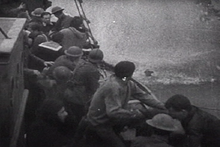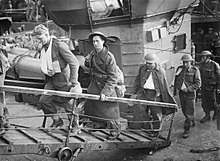Early in the war with Germany, France and England found
themselves in a precarious position. Outnumbered and outgunned, both Allied
armies were retreating to the shores of Dunkirk. Hundreds of thousands of
soldiers were packed on the beaches, waiting for rescue in whatever form it
might arrive. Many heroic events occurred and the operation was later dubbed “The
Miracle of Dunkirk.”
Christopher Nolan took this uplifting and tragic story as
the theme for “Dunkirk”.
Nolan's presentation of the story was unusual – there are three time-lines following different events of the battle/evacuation. Each line covers a different frame of time – an hour for the RAF fighter pilot, one long and excruciating day for rescuers in a small boat, and a traumatic week for soldiers on the beach/ship. The switching back and forth can be more than a little off-putting for viewers if they don’t pay close attention. And to make things even harder, there is very little dialogue in the film so viewers must be diligent in following what is happening.
Nolan's presentation of the story was unusual – there are three time-lines following different events of the battle/evacuation. Each line covers a different frame of time – an hour for the RAF fighter pilot, one long and excruciating day for rescuers in a small boat, and a traumatic week for soldiers on the beach/ship. The switching back and forth can be more than a little off-putting for viewers if they don’t pay close attention. And to make things even harder, there is very little dialogue in the film so viewers must be diligent in following what is happening.
 |
| Soldiers being helped into a fishing boat. |
My first impression was one of confusion – the different
points of view took some effort to understand (that’s why I share
that part with you here). But the more I watched, the more it became easier to
follow the story. And then the real message began to emerge.
 |
| Soldiers standing in the ocean, waiting for rescue. |
In a little more than 9 days, nearly 400,000 Allied soldiers
were rescued from the beaches of Dunkirk. Much of the success was due to the
dogged perseverance of the British citizens who risked life and limb to cross
the channel from England to France as rescuers of their protectors. Over those
days, nearly 900 small ships, mostly private vessels, traversed the seas to
ferry soldiers to larger ships that could not reach the beaches. Additionally,
these same boats were repeatedly loaded with survivors and taken all the way
back to English soil and safety. Of the many volunteer ships that crossed the
channel, 243 were sunk by enemy fire – yet the others kept coming until the
work was done.
This is not a movie like the old WWII films of my younger
days. There isn’t a lot of character development or interest in side stories. But
it is a very powerful tale from the view of participants in the events. Some are
tragic, others heroic, and the final scene with the British fighter pilot is
perhaps the most touching of the whole experience. The more I ponder the time I spent
in the theater, the more I appreciate what was shared.
It is interesting that Nolan would take such a chance with
the presentation of this story. Most directors would rely on the charisma of the actors (Kenneth Branagh and other recognizable actors have very understated roles) and side stories to guarantee the attention of viewers but he has gone a
different route. Letting events piece together the story from the choppy
time-lines and spotty dialogue invites the use of the mind and emotions to
confirm the power of the story. I wouldn’t want every film to go like this, but
I think “Dunkirk” is a fine place to practice this little bit of magic.
My favorite kind to know.

1 comment:
Thanks for your insightful review. We hope to see it soon.
Post a Comment